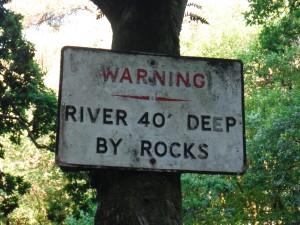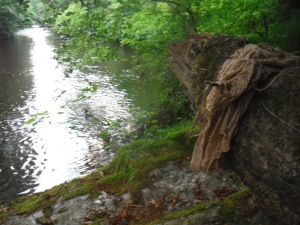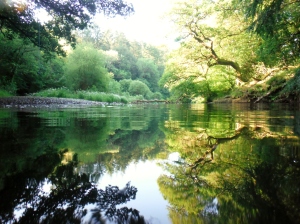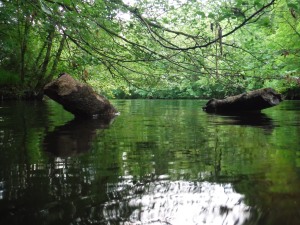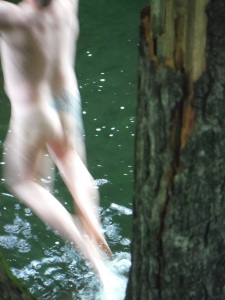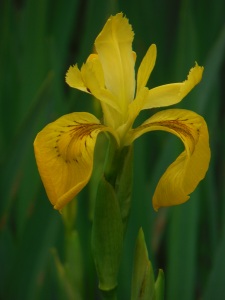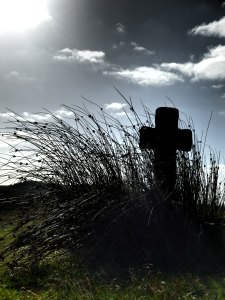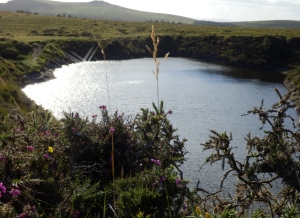If a wild swimmer can have a ‘local’ then Denham is mine.
A place of refuge, rest and relaxation. A place to swim, lie on warm sands, to dine and to dream. It’s a place for thought, for prayer and for Tai Chi. And, above all, it’s a place for fun. Somewhere that feels like home, where the family goes and knows like the back of their hand. A place of safety, a haven and a limitless playground for Marley Bone, our springer spaniel!
Denham, in particular the pools that lie waiting downstream of the bridge, will doubtless feature in many a blog, so it seems like a good idea to make some introductions…
Denham Bridge is an ancient packhorse crossing, as narrow as it is old. Crossing the River Tavy, its granite double span links the 21st Century with the timeless otherworldly villages of the Bere peninisula. At peak times the narrow lanes that transcribe a sinuous serpentine journey through meadow and woodland are anything but idyllic, as careful drivers are in as short supply as the scarce passing places that are scattered along the route.
And nowhere is more dangerous than the bridge itself, lying at the bottom of a very steep` winding gorge. There have been many accidents here – and not just on the road.
Denham Bridge is a famed site for tombstoning and on a sultry summer’s evening, the 40′ deep waters are suffused with teenage testosterone and adrenaline. But the deep section is also a narrow section – and tragedies have occurred.
Two hundred metres or so downstream is a large, wide sectiion of river that I call ‘The Silent Pool’ because that’s just what it is. The waters here are deep, black-green, lazy and languid. Wild rhodedendrons cast a purple reflection across the planed surface and when the flowers drop they resemble floating fairy hats, or tiny sailboats embarking on a gentle, unhurried passage. On the left hand bank (facing downstream) there is a wonderful rocky outcrop, perfect for changing and still draped with frayed hessian from the spates of last winter. It’s as though the river had neatly hung up her coat and then left without it!
Until recently it was easy to access this spot and the few who knew could take a narrow path through the trees to reach this micro-idyll and the small pebble beach beyond. But now the way is barred with barbs and the fun, for many, has been stolen. Oh to be in Scotland where the law grants almost universal access to rivers. In England and Wales, there are 40,000miles of river – but access is permitted along only 2% of these miles. Time to join the ‘River Access Campaign’?
So in order to reach the Silent Pool, I now have to climb down off my soapbox and use the right hand bank via an uppity downity sort of public footpath, frequently traversed by fallen trees that the landwowner has so far omitted to clear. Nothing that cannot be clambered around or ducked under though….
Access to the river here can be a little tricky when wet, for there is a muddy bank which leads to a partly submerged plateau. This drops suddenly into deep water where the current can be a little frisky, so caution is required. As always, it is important to read the flow, the eddies and the currents before diving in – and also to know exactly where you can get out.
Partially submerged trees, looming up like icebergs provide an additional hazard in this stretch of water.
Following the path downstream, one enters a large clearing – unswerving trunks rising from a rustling russet beech leaf carpet where generations have carved pledges of love into the scarred bark. A broken rope swing hangs limp and useless from a sturdy bough. Alone in the stillness of twilight, this is a serenely beautiful, almost magical space.
Beyond the woods is a small grassy plain, where high stems have been beaten down in the centre to accommodate tents, for this is frequently a place of campfires, guitar and song, a perfect pitch that leads to a long boulder beach. Here the rounded grey stones have been stacked high by January floods and the river is wide, shallow and loud. In the dry months, islands of cow pasley sprout in the middle of the river and both wagtails and dippers are frequent visitors.
Around the next bend is my heaven. I call it Denham Beach. Here the stillness of the water signals its depth, A small, secluded and unusually sandy beach slopes down into the peaty water. Boulders are few so the tread is easy. From this place there is an effortless channel in which to swim against the flow, then a place to cross the current and be wafted into a large, gently circulating lake. This spills the swimmer back out into the main stream where one can backfloat, gently spinning under a canopy of trees and open skies.
The river then naturally nudges one into a moss-softened rocky outcrop that slopes so gently into the water that it can be climbed like a gangplank. From here it is a mere leap back into the deep water and the muffled world of the river bed where, rising through bubbles and starbursts of scattered sunlight the whole figure of eight cycle begins again.
In this quiet spot, shielded by an overgrown river bank, I usually bathe in the buff. To peel off one’s clothes, leave them lying in the warm sand and just walk into the embrace of the river is a wonderful thing. To swim free and dive deep, to kick out and lie back is a luxury. To float under the dazzling flash of a kingfisher and to hear the laborious wings of a heron rising behind you is a blessing.
To commune with the river is a privilege.
This is my place.
This is my local.



